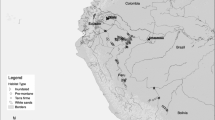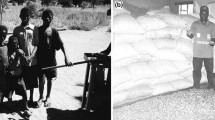Abstract
Vateria indica is a critically-endangered and economically-important tree endemic to the Western Ghats, a biodiversity hotspot in India. Due to extreme local endemism and anthropogenic destructive harvesting of resin, the species is categorized as critically endangered. The present study investigated the biotic limiting factors of recruitment of V. inidica in its natural populations, and studied the pattern of anthropogenic harvest of nuts of V. indica in the recent past. Seed predation and seedling herbivory particularly by insects were assessed. The sustainability of the nut harvest was assessed by conducting pre- and post-harvest censuses of nuts on forest floors. Over 90 % of the fruits of V. indica were infested by the insects, but, only about 10 % of the infested fruits were seed-predated. Seedling herbivores included a leaf miner, ants of two species, and larvae of a lymantrid moth. Seedling mortality due to herbivores was moderate (45.5 %). Pre- and post-harvest censuses showed that only 3.81 % of the fruits that were naturally-fallen on the forest floor were spared after the harvest had taken place. Sringeri has exported 820 metric tons of nuts in the study year, which was an all-time high estimate. The study concludes that the anthropogenic nut collection can hamper the population structure of V. indica locally. Since V. indica has an alternate-year major flowering cycle, the seed loss as seen in the present study is critical. Raising plantations of V. indica as an afforestation program can contribute to the conservation of the species and the development of local communities.



Similar content being viewed by others
References
Crawley MJ (1992) Seed predators and plant population dynamics. In: Fenner M (ed) Seeds: the ecology of regeneration in plant communities. CABI Publishing, Wallingford
Gunatilleke HM, Senaratne AH, Abeygunawerdena P (1993) Role of non-timber forest products in the economy of peripheral communities of Knuckles National Wilderness area in Sri Lanka: a farming system approach. Econ Bot 47:275–281
Godoy R, Brokaw N, Wilkie D (1995) The effect of income on the extraction of non-timber tropical forest products: model, hypotheses, and preliminary findings from the Sumu Indians in Nicaragua. Hum Ecol 23:29–52
Peres CA et al (2003) Demographic threats to the sustainability of Brazil nut exploitation. Science 302:2112–2114
Ganesan R, Setty RS (2004) Regeneration of amla, an important nontimber forest product from Southern India. Conserv Soc 2:365–375
Rai N, Uhl CF (2004) Forest product use, conservation and livelihoods: the case of Uppage fruit harvest in the Western Ghats, India. Conserv Soc 2:289–313
Peters CM (1996) The ecology and management of non-timber forest resources. Technical paper. World Bank, Washington, DC
Hartshorn GS (1995) Ecological basis for sustainable development in tropical forests. Annu Rev Ecol Evol S 26:155–175
Murali KS et al (1996) Extraction of non-timber forest products in the forests of Biligiri Rangan Hills, India. 2. Impact of NTFP extraction on regeneration, population structure and species composition. Econ Bot 50:252–269
Curran LM, Leighton M (2000) Vertebrate responses to spatiotemporal variation in seed production of mast-fruiting Dipterocarpaceae. Ecol Mon 70:101–128
Lyal CHC, Curran LM (2000) Seed-feeding beetles of the weevil tribe Meoysolobini (Insecta: Coleoptera: Curculionidae) developing in seeds of trees in the Dipterocarpaceae. J Nat Hist 34:1743–1847
Nakagawa M et al (2003) Resource use of insect seed predators during general flowering and seeding events in a Bornean dipterocarp rain forest. Bull Ent Res 93:455–466
Nakagawa M, Takeuchi Y, Kenta T, Nakashizuka T (2005) Predispersal seed predation by insects vs. vertebrates in six dipterocarp species in Sarawak. Biotropica 37:389–396
Maury-Lechon G, Curtet L (1998) Biogeography and evolutionary systematics of dipterocarpaceae. In: Appannah S, Turnbull JM (eds) A review of Dipterocarpaceae: taxonomy, ecology and silviculture. CIFOR, Indonesia
Shiva MP, Jantan I (1998) Non-timber fotest products from dipterocarpaceae. In: Appannah S, Turnbull JM (eds) A review of Dipterocarpaceae: taxonomy, ecology and silviculture. CIFOR, Indonesia
Nayar TS, Beegam AR, Mohanan N, Rajkumar G (2006) Flowering plants of Kerala—a handbook. Tropical Botanical Garden and Research Institute, Thiruvananthapuram, Kerala
Hall P, Bawa KS (1993) Methods to assess the impact of extraction of non-timber tropical forest products on plant populations. Eco Bot 47:234–247
Khurana E, Singh JS (2001) Ecology of tree seed and seedlings: implications for tropical forest conservation and restoration. Curr Sci 80:748–757
Mack AL (1998) An advantage of large seed size: tolerating rather than succumbing to seed predators. Biotropica 30:604–608
Becker P (1983) Effects of insect herbivory and artificial defoliation on survival of seedlings of Shorea. In: Sutton SL et al (eds) Tropical rain forest: ecology and management. Blackwell, Oxford
Chivers DJ (1980) Malayan forest primates. Plenum Press, New York
Elouard C (1998) Pests and diseases of Dipterocarpaceae. In: Appannah S, Turnbull JM (eds) A review of Dipterocarpaceae: taxonomy, ecology and silviculture. CIFOR, Indonesia
Ashton PS (1988) Dipterocarp biology as a window to the understanding of tropical forest structure. Annu Rev Ecol Evol S 19:347–370
Ruiz-Pérez M et al (2004) Markets drive the specialization strategies of forest peoples. Ecology and Society 9(2): 4.[online] http://www.ecologyandsociety.org/vol9/iss2/art4
Bagchi RRE et al (2014) Pathogens and insect herbivores drive rainforest plant diversity and composition. Nature 506:85–88
Acknowledgments
The authors thank all the participated farmers, middleman traders, whole sale dealer and LAMP society officials of Koppa and Sringeri taluks for their cooperation. Support for the study was provided by the Department of Science and Technology, New Delhi and Conservation, Research and Exploration Committee of the National Geographic Society, Washington DC. The authors declare no conflict of interest. They thank the anonymous reviewers for their constructive comments in the previous versions of this paper.
Author information
Authors and Affiliations
Corresponding author
Rights and permissions
About this article
Cite this article
Sinu, P.A., Shivanna, K.R. Factors Affecting Recruitment of a Critically-Endangered Dipterocarp Species, Vateria indica in the Western Ghats, India. Proc. Natl. Acad. Sci., India, Sect. B Biol. Sci. 86, 857–862 (2016). https://doi.org/10.1007/s40011-015-0535-8
Received:
Revised:
Accepted:
Published:
Issue Date:
DOI: https://doi.org/10.1007/s40011-015-0535-8




